5.3
New South Wales, Australia
5.3.1 Four Horizons House and Lodges, New South Wales, Australia
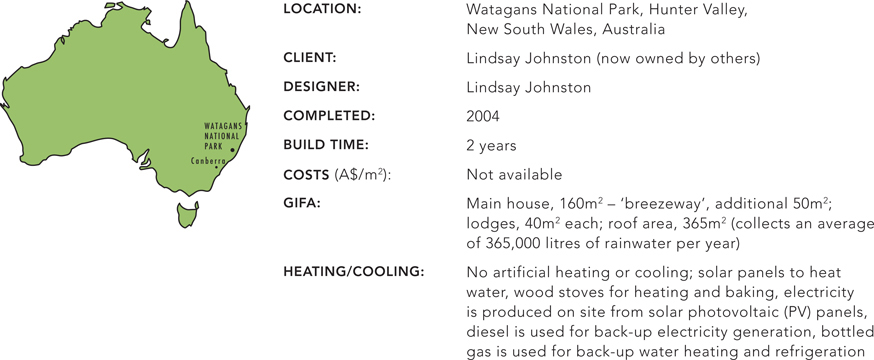
The Project
Lindsay Johnston began practising as an architect in Ireland and moved to Australia during the 1980s recession, which left little work for architects. He taught at the universities of Newcastle (Australia) and Sydney as well as practising.
The Four Horizons House, so called because it has a view to the Barrington Tops (‘four horizons away’), is where the architect and his family lived for 10 years. There are also three tourist lodges, which use variations of the strategies employed on the main house.
It is impossible to talk about Contemporary Vernacular Design in Australia without mentioning Glenn Murcutt, a great friend of Johnston’s. Murcutt’s work exemplifies Contemporary Vernacular Design, marrying his love of Mies van der Rohe with a wonderful understanding of both Australia’s climate and its beauty. His buildings have a lightness of touch; they grace the landscape with their presence, as though it was waiting for them to arrive. Whether a Murcutt roof is flat or pitched derives entirely from levels of rainfall; the amount of shade derives from the position of the sun; ventilation, essential in Australia, is carefully considered – all while creating a home not just of beauty, but one that gives the occupants great levels of joy.
Context
Johnston explains that the Australian climate varies, from arid desert to alpine and tropical zones. He believes that, in many ways, it was the agricultural buildings that were the most responsive to the local conditions and that best used local materials. We think of Australian architecture as the ‘Queenslander’ – a timber-stud house built on stilts, very lightweight and surrounded by a large veranda. This suits the tropical environment in which it sits, but New South Wales has a very different climate, to which thermal mass is actually better suited.
The temperature range in New South Wales is 4 to 24°C in winter; in summer, it is 14 to 38°C. Rainfall has averaged 1,100mm per annum.1

5.3.2 The Four Horizons House.

5.3.3 Simpson-Lee House, Mount Wilson, New South Wales, by Glenn Murcutt.
The landscape in Watagans National Park is heavily forested with stunning views (from the project described here) across four horizons. Bush fires are a real issue, and it is a non-smoking area.
Vernacular House Type
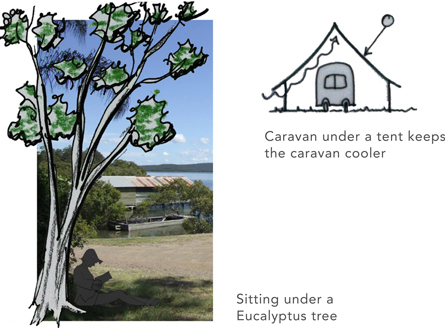
5.3.4 Environmental design strategy of the Four Horizons House (taken from information on Lindsay Johnston’s drawings).

5.3.5 Four Horizons House: layout plan.
It is tricky to say what Australian vernacular/indigenous architecture is, as the Aboriginal people did not have buildings as such but rather settlements linked to trees, rocks, caves and concepts of shelter. When white settlers arrived about 200 years ago, they brought European styles with them, which were, of course, not suited to a variable climate such as Australia’s. It is therefore not surprising that some Australian architects – such as Murcutt, Peter Stutchbury, Richard Leplastrier and Lindsay Johnston – refer to the vernacular as the agricultural building, as that seems to best represent a building suitable for Australian climates.
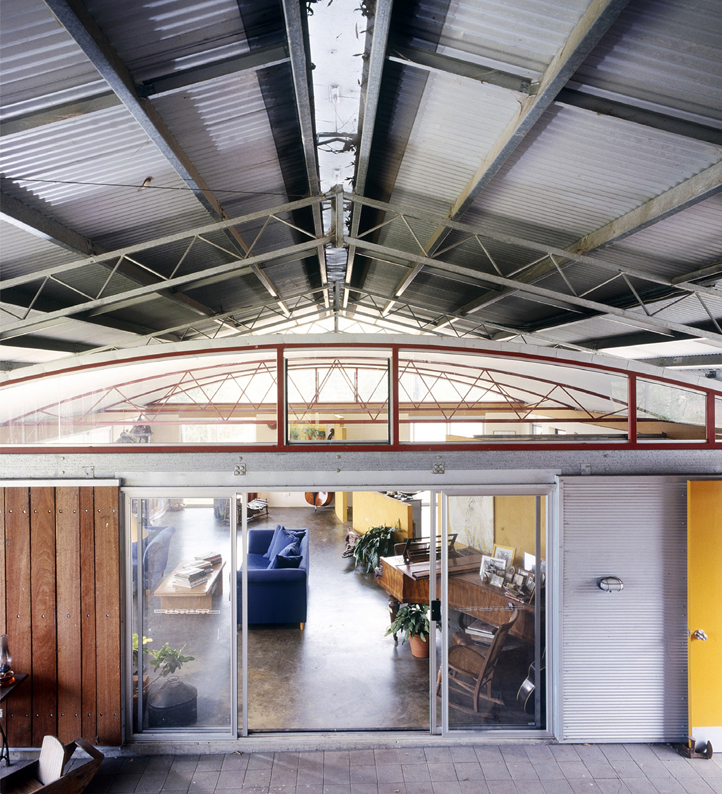
5.3.6 Four Horizons House: the ventilated double roof, looking from the ‘breezeway’ towards the living room.
Johnston explained that the Irish cleared their land of stones to allow space for agriculture, and used the stones for building. In Australia, the white settlers cleared the land of timber to allow for agriculture, and used the timber for building. The main difference between Britain/Ireland and Australia is that buildings historically in Britain and Ireland used mass for stability, whereas in Australia they were built as frames. At first the settlers used timber, but they then imported cast iron from Scottish foundries, so system building and steel frames are quite traditional in the Australian context.
The Design Approach by Lindsay Johnston
A very simple strategy used by some Australian architects is the idea of sitting under a tree. The Four Horizons House and its lodges have forms drawn from the rural-shed vernacular, but mostly from the idea of shade. People gravitate towards trees in hot climates, and ‘park their caravans under another roof’. Johnston was also inspired on a trip to Zimbabwe, where tents were situated under a thatched roof and there was a fireplace outside.
The large roof on the Four Horizons House provides two things: shade and rainwater collection. All the properties are completely off grid, with no air conditioning, so this is important. Another key consideration is cross ventilation, something that also features heavily in Murcutt’s work. There is a central ‘breezeway’ in the middle
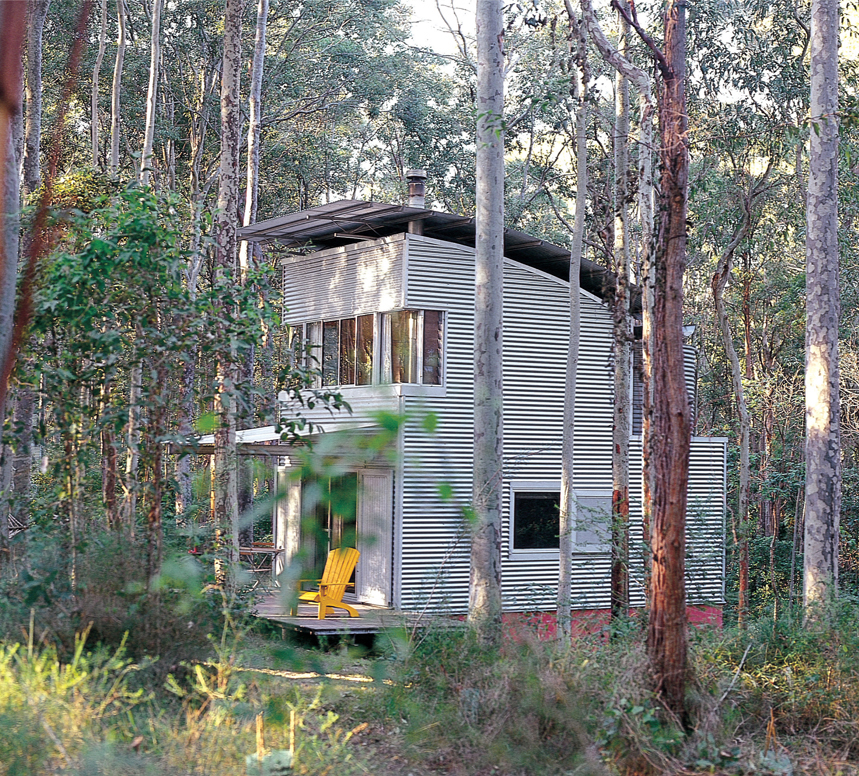
5.3.7 A Four Horizons lodge, seen through the trees.
5.3.8 Lodge section.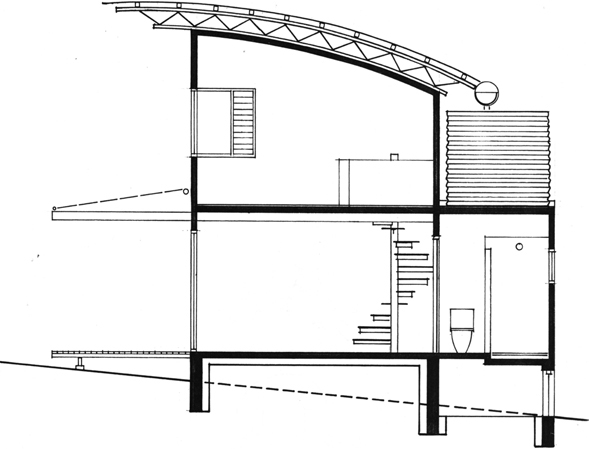
of the house, used as an outdoor room with a roof. Cross ventilation occurs continuously between the two roofs. The house is insulated, but to a lesser degree than current UK building regulations require. This means that the thermal mass has a far bigger effect than the insulation. These passive thermal strategies form part of its off-grid status.
Other considerations were the immediate bushfire risk (the house is set on a cliff, with forest all around). The building can be completely sealed up, using fire shutters to prevent fire from entering. This allows you to hide inside until the blaze passes. One criticism that Johnston often has of buildings built by newcomers to Australia is that they have no appreciation for thermal mass or the Australian lifestyle of eating outside. Both of these things are incorporated into his design, using dense concrete block and the breezeway. Thermal mass is very important, and very effective, in the New South Wales climate.
While the overall embodied energy of the house is very similar to that of a ‘stick’ build with brick-tile cladding (typical of Australian suburbs), Johnston also carried out many calculations on the embodied energy of the ecologically controversial steel and aluminium used on the build, and discovered that he saved more energy by switching to a more efficient car than by worrying about these materials. The overall CO2 emissions of the Four Horizons House is in the region of 20–30% of those from typical Australian houses.
Resident Feedback
INTERVIEWEE DETAILS: Lindsay Johnston (architect)
Comfort
The house faces north-east, so that winter morning sun warms the living and main bedroom areas. However, the building sits far enough back from the shade provided by the top roof that the higher summer sun cannot reach the concrete walls, but the lower winter sun can. Overall, the house was cool in summer and warm in winter. In winter, they always had a wood fire in the living room – mainly for aesthetic purposes. Johnston says that it was very rarely too hot and never too cold: when outside became hotter than inside, you shut all the doors and windows and let the thermal mass do the work. They had 38°C days and the house performed very well. Johnston refers to it as probably one of the best houses for thermal comfort he’s ever been in, in Australia. In terms of psychological comfort, he says it was frugal, hard and raw – but his wife loved it, and still says it was one of her favourite houses. But when they moved on, she said, ‘I’d like the next house that we have to be ‘“homely”’ – and that’s something that he feels doesn’t really appear in Four Horizons’ architectural language.
Appropriateness
There is something extremely appropriate about these houses – Johnston told me that he was lucky to have found a buyer for his Four Horizons home who themselves had left a home designed by an award-winning architect. For most people (in Australia at least), he believes that the appearance is probably too crude; as mentioned in ‘What is Contemporary Vernacular Design?’ (see Part 1, Section 1.2, page 13), Johnston thinks that many in Australia would prefer to live in something that looks like Windsor Castle.
Sustainability
The simplicity and easy availability of the materials used inform a sophisticated Contemporary Vernacular Design for our time. The strength of shaded thermal mass and the double roof in the New South Wales environment provides an air-conditioning-free home in a hot climate. This is no mean feat: in 2011, around 73% of Australian homes had at least one air conditioning unit.2 Built with cheap and honest materials, these designs could be so easily replicable.
Improvement
Shaded thermal mass has proved to be a great improvement environmentally for New South Wales – far better than the widespread timber frame with a brick ‘veneer’, as Johnston calls it. The Four Horizons buildings are award-winning for their environmental design but also manage to not appear ‘eco’, simply sitting well in their bush surroundings. This is a very wild landscape and one could argue that buildings should not exist in this setting. But these well-designed homes feel like they belong there.
